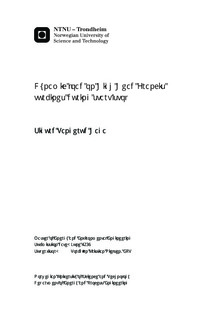| dc.contributor.advisor | Nielsen, Torbjørn Kristian | nb_NO |
| dc.contributor.author | Haga, Sigurd Tangerud | nb_NO |
| dc.date.accessioned | 2014-12-19T11:52:15Z | |
| dc.date.available | 2014-12-19T11:52:15Z | |
| dc.date.created | 2014-09-05 | nb_NO |
| dc.date.issued | 2014 | nb_NO |
| dc.identifier | 744088 | nb_NO |
| dc.identifier | ntnudaim:11398 | nb_NO |
| dc.identifier.uri | http://hdl.handle.net/11250/235602 | |
| dc.description.abstract | Pressure measurements were performed on the Francis runner in the Waterpower laboratory at NTNU. These measurements were divided into start and stop procedures, with the generator on or off. The suggested method that was used to identify the pressure oscillations during the start and stop procedures consisted of finding curves that fit the performed pressure measurements. The MATLAB application Curve Fitting Tool was used to find the curves that fit to the performed pressure measurements. A FFT analysis was then performed on the difference between the measurements and the fit curve to identify the pressure oscillations experienced during the measurements in the laboratory. The FFT analysis showed few signs of interference from the suggested method.The results from the FFT analysis showed that the largest frequency experienced was the blade passing frequency and it was observed during the start and stop procedures, as well as for BEP and part load operation. The guide vane frequency was not observed, this is due to the lack of functioning transducer in the runner blades. The Rheingan frequency had higher peak values during the stop sequence compared to startup. The reason for this is believed to be the chaotic flow pattern experienced in the draft tube cone during the startup sequence. The runner frequency was not observed during the performed procedures. For the occurring frequencies the part load operation resulted in larger pressure amplitudes compared to the start and stop procedures. Elastic oscillations were experienced both upstream and downstream of the turbine. To determine the structural behavior of the runner during the start and stop procedures proper instrumentation in the runner is needed. Improving the instrumentation is strongly advised to further analyze the structural behavior of the runner during the start and stop procedures.By improving the instrumentation on the Francis rig it is possible to perform transient load measurements on the runner during start and stop procedures. There is especially a need to perform measurements along the runner blades to further analyze the effect of the dynamic load on the runner. This can be done by replacing the current defect runner blade transducers, and with a slight modification of the transducer cables to make them stick to epoxy. It is also possible to located more pressure transducers at the upper draft tube cone. This is to perform more measurements on the chaotic flow that was experienced in the draft tube cone during the runner startup. The usage of accelerometers are suggested to determine the occurrence of vibration and cavitation. By installing the accelerometer on top of the guide vane trunnion it is possible to determine the wake and cavitation bubbles occurring from the guide vanes and traveling into the runner. Attaching an accelerometer on the ball-bearings to measure the wear on the ball-bearings while experimenting on how the guide vane angle during startup procedures effects the stress fluctuations on the runner. Strain gauges can also be used simultaneously with pressure transducers along the blade to determine both the pressure and strain occurring along the runner blades. Simultaneous pressure and strain gauge measurements were not performed due to the lack of rapid prototyped runner blades. With the suggested improved instrumentation it is possible to perform these measurements for both the original and rapid prototyped runner blades. | nb_NO |
| dc.language | eng | nb_NO |
| dc.publisher | Institutt for energi- og prosessteknikk | nb_NO |
| dc.title | Dynamic load on High Head Francis turbines during start/stop | nb_NO |
| dc.type | Master thesis | nb_NO |
| dc.source.pagenumber | 156 | nb_NO |
| dc.contributor.department | Norges teknisk-naturvitenskapelige universitet, Fakultet for ingeniørvitenskap og teknologi, Institutt for energi- og prosessteknikk | nb_NO |

